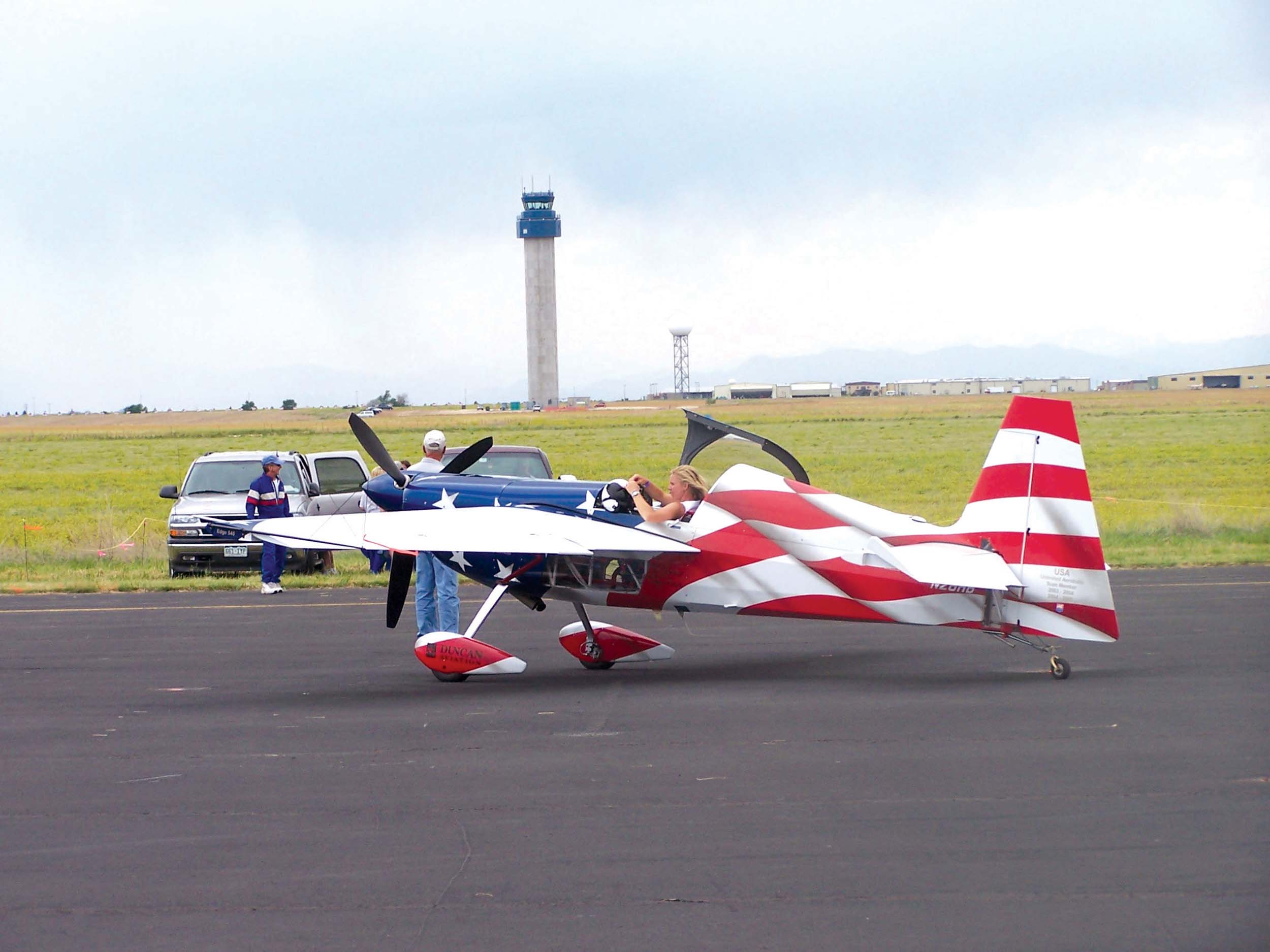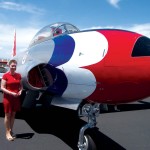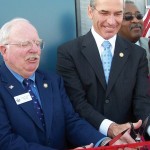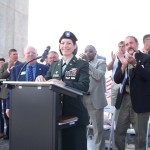By Bill Stansbeary

Chandy Clanton puts on a flight helmet in an Edge 540 before her aerobatic performance; the new FTG control tower is in the background.
On June 25 and 26, the Rocky Mountain EAA Fly-In was held at Front Range Airport. The airport’s new air traffic control tower was dedicated during the event.
A wide range of aviation subjects was covered during a forum schedule. Workshops were held to advance education in aviation, and a large number of exhibitors showed their aviation products and services to attendees.
The Experimental Aircraft Association is an all-volunteer organization dedicated to providing safe, enjoyable family experiences that inspires aviators to look to the sky. The Rocky Mountain EAA Region local chapters get together one weekend out of the year to promote aviation, celebrate the freedom of flight, support the community, and give the proceeds to local children by means of education grants and scholarships.
Denny Cunningham, air boss, organized the air show with performances by Michael Hunter in his Edge 540, Chandy Clanton in her Edge 540, and Randy Harris in his Super Skybolt. The Colorado National Guard did a helicopter parachute jump in a CH-47. Fly-bys were performed by Mike Bertz in a P-51 Mustang, Mark Johnson in a Venom, Don Nelson in his Sukhoi 26 and Jack Wilhite in his MiG-17. Mass formation flights were performed by the Red Star Pilots Association, Terry Calloway and Rodger Modglin and Team Red. The Colorado Air National Guard had an F-16 on static display.
George Meshko, a WWII B-17 flight crewmember, was the guest speaker at an awards banquet. For his outstanding service and dedication, Meshko was awarded the Air Medal with three Oak Leaf Clusters and the Distinguished Flying Cross, which was presented personally by legendary General James Doolittle. Meshko completed his combat tour just two weeks before his 19th birthday.
The FAA, Denver Flight Standards District Office, presented the Charles Taylor Master Mechanic Award to Dennis Lamer. The Wright Brothers Master Pilot Award went to Harry Blout, Dr. David Callender, Rudolph Welch and Jack Wilhite.
The Rocky Mountain EAA Regional Fly-In presented the award of Grand Champion to Gary Miller for a Cessna 180. Warbird 1st place went to Gary Miller for his T-6; Classic to David Hay for a Luscombe 8A; Contemporary to Mike Forney for a Cessna 182; Custom/Modern to Robert Senser for a Cirrus SR 22; and Homebuilt-Kit to John Stewart for his Vans RV-10. Homebuilt-Plans 1st place went to Patrick Fagan for his Bearhawk; Homebuilt-Composite to Richard Steward for a Glastar; Homebuilt-Metal to Terry Jackson for an RV-6; Homebuilt-Tube and Fabric to Daniel Michalak for his Kitfox; and Homebuilt-Wood to Duane Root for a Falco.
Tower dedication

Michael and Sheila Morris exhibited their BD-5J as part of their Wild Wings n Things franchise development business based in Colorado Springs.
Dennis Heap, director of aviation at Front Range Airport, led ceremonies for the dedication of a new air traffic control tower at FTG on June 25. Lt. Col. Laura Richardson was guest speaker. Other speakers included Larry Pace, chairman of the Front Range Airport Authority; Congressman Bob Beauprez; Travis Vallin, Colorado Division of Aeronautics; and Harold Thomas, Federal Aviation Administration.
At 192 feet, the ATC tower is the tallest general aviation tower in the United States. Standing at a minimum viewing height of 5,596.8 feet MSL and a tower cab floor height of 190.6 feet AGL, the tower expands Front Range Airport’s capabilities to include business jet aircraft, previously unable to use the general aviation airport. The tower will add to already exponential growth at FTG, located six miles southeast of Denver International Airport.
In ten years, Front Range has experienced nearly 300 percent growth in “based aircraft,” growing from 132 planes based at the airport in 1994 to 391 in 2005. A recent study (Economic Impact of Airports in Colorado) by CDOT-Division of Aeronautics credits the airport with 740 direct and indirect jobs, an increase of 320.5 percent since the previous study in 1998.
The airport opened in 1984. Heap noted that the tower is the most significant project to affect the airport since the development of the north/south runway in 1993.
At a total cost of $5.7 million, planning for the tower began in October 2000. Funding for the tower has been a national partnership, including $2.92 million from the Federal Aviation Administration secured by Congressman Bob Beauprez, a loan from CDOT-Division of Aeronautics of $950,000, a grant from the Division of Aeronautics of $250,000 and a $500,000 financial contribution from Hunt Broadcasting. Remaining funding came from Adams County and the airport.
The tower was designed by URS Corporation and constructed by Hensel Phelps Construction Co. The ATCT will be operated under the FAA Contract Tower Program and will have management oversight by the FAA’s Denver TRACON (Terminal Radar Approach Control). A total of 229 smaller airports in 46 states currently participate in the FAA’s Federal Contract Tower Program, representing 45 percent of all control towers in the country.

Sandy and JoAnn Hill, National Association of Flight Instructors vice presidents, were also the seminar coordinators at the Rocky Mountain EAA Regional Fly-In.
The Front Range Airport Authority, created by Adams County in 1982, governs the airport. FTG is being developed as part of a 10,000 acre, non-residential multi-modal cargo complex in conjunction with Schuck Communities/TransPort.
Richardson’s remarks emphasized the importance of safe aviation operations in military and civilian air traffic control. Commissioned as a second lieutenant aviation officer in 1986 upon graduation fro Metropolitan State College of Denver, Richardson has served as a Blackhawk helicopter platoon leader in Korea and as a military aide to the vice president, 1999 to 2001, in Washington, D.C. She’s now assigned to the Pentagon working on the Army staff in the Deputy Chief of Staff G3 unit as strategic plans officer.
- L to R: Congressman Bob Beauprez meets with George Bye, Aviation Technology Group president, during the dedication of the new ATC tower at Front Range Airport.
- Chris Lucas, FAA Denver Flight Standards District Office awards committee chairperson, stands alongside a T-33 in Thunderbird markings flown by Roy Halliday.
- Larry Pace, chairman of the Front Range Airport Authority, and Congressman Bob Beauprez cut the ribbon to dedicate the new tower at FTG.
- Lt. Col. Laura Richardson was the guest speaker at the dedication ceremony for Front Range Airport’s new air traffic control tower on June 25.
- George Meshko, WWII B-17 crewmember, was the guest speaker at the awards
















